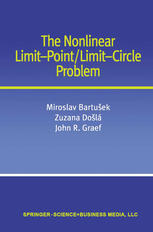

Most ebook files are in PDF format, so you can easily read them using various software such as Foxit Reader or directly on the Google Chrome browser.
Some ebook files are released by publishers in other formats such as .awz, .mobi, .epub, .fb2, etc. You may need to install specific software to read these formats on mobile/PC, such as Calibre.
Please read the tutorial at this link: https://ebookbell.com/faq
We offer FREE conversion to the popular formats you request; however, this may take some time. Therefore, right after payment, please email us, and we will try to provide the service as quickly as possible.
For some exceptional file formats or broken links (if any), please refrain from opening any disputes. Instead, email us first, and we will try to assist within a maximum of 6 hours.
EbookBell Team

4.7
106 reviewsFirst posed by Hermann Weyl in 1910, the limit–point/limit–circle problem has inspired, over the last century, several new developments in the asymptotic analysis of nonlinear differential equations. This self-contained monograph traces the evolution of this problem from its inception to its modern-day extensions to the study of deficiency indices and analogous properties for nonlinear equations.
The book opens with a discussion of the problem in the linear case, as Weyl originally stated it, and then proceeds to a generalization for nonlinear higher-order equations. En route, the authors distill the classical theorems for second and higher-order linear equations, and carefully map the progression to nonlinear limit–point results. The relationship between the limit–point/limit–circle properties and the boundedness, oscillation, and convergence of solutions is explored, and in the final chapter, the connection between limit–point/limit–circle problems and spectral theory is examined in detail.
With over 120 references, many open problems, and illustrative examples, this work will be valuable to graduate students and researchers in differential equations, functional analysis, operator theory, and related fields.